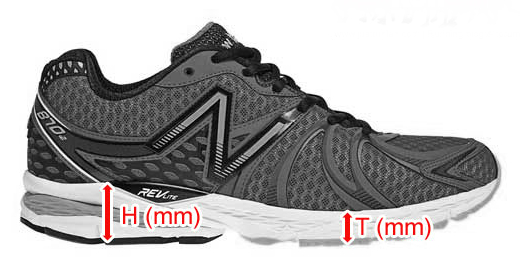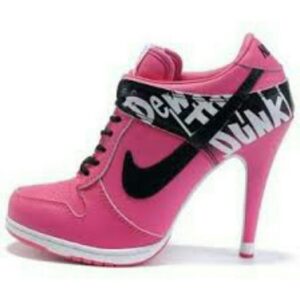Choosing the right shoe for you
Mark Green

There are a number of common questions which crop up when people are trying to decide which pair of running shoes to buy:
- What does stack height do?
- What is the ideal stack height for ultras?
- What is the maximum distance you can run in thinner stack shoes?
- Do you need more stack for a marathon than a half marathon?
- What is the pitch of a shoe?
- What does pitch do?
- What pitch is best?
Let’s start with the basics:
 Stack = The total amount of shoe under your foot (usually measured in mm’s). More stack effectively equals more cushioning, although the firmness or density of the midsole (the white bit) makes a big difference to how cushioned the shoe feels as well.
Stack = The total amount of shoe under your foot (usually measured in mm’s). More stack effectively equals more cushioning, although the firmness or density of the midsole (the white bit) makes a big difference to how cushioned the shoe feels as well.
Pitch = The height difference between the front of the shoe and the back of the shoe (also measured in mm’s). This changes the angle of your foot relative to the ground.
What Does Stack Height Do?
Stack Height is easiest thought of as the amount of cushioning the shoe will give you. More stack = more cushioning, although there are variations which you need to bear in mind. You might try on a shoe that is 24mm – 20mm for example. So the height at the heel is 24mm and at the toe is 20mm (giving a pitch of 4mm). If this shoe was made with soft and springy midsole material then it might feel more cushioned than a shoe which is 30mm – 26mm but is made out of firm midsole material. Which of these two options you should choose depends mostly on comfort.
Impact forces are a contributing factor in some running injuries (shin splints and stress fractures for example). For these type of injuries more stack height is likely to provide more protection.
What is the ideal stack height for ultras?
There isn’t an ideal stack height for any race distance. It is a common misconception that when you run further you need more stack because you need the extra cushioning. For some people this is true, and for others it isn’t. It depends on your body, your conditioning and your running technique. If you are flexible and strong and you run with good technique, then you should be able to run any distance in any shoe. Every year dozens of people run the Comrades Marathon (90km on a road) in barefeet without injuries. That’s not to say it is necessarily a good idea, but it does show that not everyone needs cushioning in long events.
What is the maximum distance you can run in thinner stack shoes?
It depends on your body, but you can ultimately run any distance in any shoe. If there is a reason you prefer thinner shoes, and you want to wear them for a long race, then you should focus on improving your running technique and your biomechanics, and allow enough time for your body to adapt to the thinner shoes gradually.
An example of this would be a trail runner with “wobbly” ankles. If you have a history of sprained ankles, then high stack shoes carry more risk of another sprained ankle. The higher you are off the ground, the worse your proprioception (sense of balance) becomes. This trail runner would benefit from running on trails in thinner stacked shoes, but they would need time for their body to adapt to them if they weren’t used to them.
Do you need more stack for a marathon than a half marathon?
Not necessarily. More stack will be helpful if you have a history of stress fractures or shin splints, but it wont help as much as improving your flexibility, strength and running technique. Putting the time and effort into improving your body will pay much bigger dividends in the long term than searching for the perfect shoe!
What is the pitch of the shoe?
The pitch of a running shoe is the relative height difference between the heel and the toe of the shoe. It is usually described in mm’s. From the early 1970’s when cushioned shoes were first invented the pitch of running shoes got higher and higher up to about 14mm. Since the minimalist running movement gained momentum in 2009 most companies have reduced the pitch of some of their shoe range again. Most running shops now stock a range of shoes with pitches varying between 0mm – 12mm.
What does pitch do?
The pitch of the shoe changes the way our foot contacts the ground, and it changes where the ground reaction forces occur in our legs. Higher pitch shoes typically put more pressure on the front of our knees and on our lower backs, while lower pitch shoes put more pressure on our calf muscles and achilles tendons.
What pitch is best?
The best pitch of shoe for you depends primarily on how flexible you are through the calf muscles and ankle joints. If you have very stiff ankles and calves and you have been running in shoes which are 10mm-14mm pitch for a long time, then dropping down to a 4mm pitch shoe is likely to cause calf muscle and achilles issues.
Ideally, over time, you will benefit from improving your body to a point where you are comfortable and safe running in low pitch shoes (0mm – 4mm). Our feet are naturally zero drop, so zero drop (0mm pitch) is how millions of years of evolution has designed us to run. Having a lower pitch allows us to use our calf muscle and achilles tendon as a spring which improves our running efficiency and economy.
Golden Rules to follow when buying your next pair of shoes:
 Don’t change into a dramatically different shoe – change the stack height and the pitch by a small amount each time you buy new shoes, allow your body time to adapt, then change again if you want to.
Don’t change into a dramatically different shoe – change the stack height and the pitch by a small amount each time you buy new shoes, allow your body time to adapt, then change again if you want to.- Aim to improve your body and your running technique rather than looking at the shoes as the answer to either your speed or your injuries.
- Ideally have a variety of shoes – buying different brands with slightly varying pitches and stack heights means you will be changing the forces that your body is exposed to. Most running injuries are caused by repetition. Mixing up your shoes reduces the repetition, so reduces your chance of experiencing overuse injuries.
Here are two more running shoe articles you will find helpful in your quest to finding your ideal shoe: